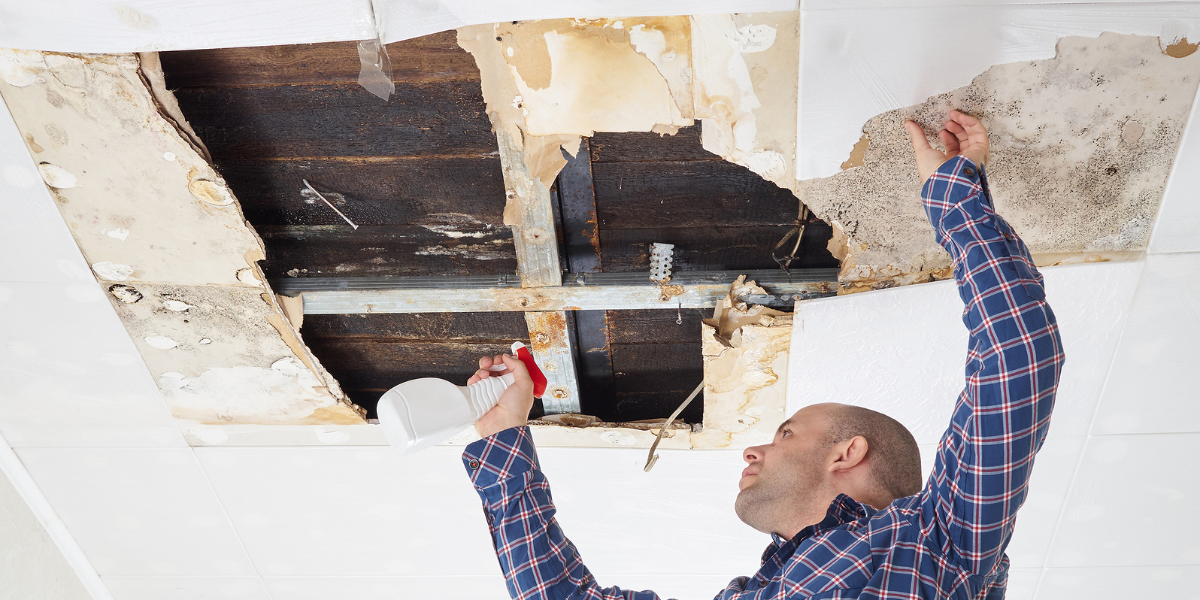Mold poses huge risks for every home. Homeowners know that but sometimes even after engaging in both natural and artificial cleaning solutions, prevention measures, and keeping eye out for every whiff of mold, there’s a kind of mold that does go unnoticed: Mold inside the walls.
We’ll soon go into the signs so you’ll be able to detect it like a precise hunter but take a look at these hazards caused by molds. According to a study by the Centers for Disease Control and Prevention (CDC), about 50% of homes in the United States have mold. Now, that’s a lot but not every home has the possibility of mold being inside the walls where it goes often undetected. Still, mold generally has accounted for a lot of health issues in the world.
Health issues like respiratory issues, coughing, wheezing, itchy eyes and throat, runny noses, skin irritation, various types of allergic reactions, neurological problems like memory loss, headaches, and the list goes on and on.
According to a report by the World Health Organization (WHO), the cost of treating mold-related health problems is estimated to be $3.5 billion annually. But that’s not all, damages caused by mold exceed our health.
Mold can also cause significant damage to your home structure. It ruins the property, including walls, ceilings, carpets, and furniture. In fact, the Insurance Information Institute found out that mold-related property damage in the United States results in an estimated $3 billion in annual costs.
The deterioration process starts slowly, then when the Mold lingers for long in the home, it becomes harder to remove. That’s why some homes go as far as to be demolished or reconstructed. The property value has gone incredibly low, it has become more difficult to sell, and the repair and renovation costs are huge
The mold we’re talking about, especially today, is the most guilty of that: mold inside walls. Finding out how to kill mold inside walls should be a priority if you suspect a problem. Before you learn how to remove mold from inside walls, you’ll have to know the exact signs to look for.
Common Signs of Mold Inside Walls
Mold inside the walls can be tricky and you might have to try different approaches before you begin to remove them. If you’ve been suspecting a mold problem but can’t seem to find the signs on the surface of the walls, then you need to test for one of these signs.
Musty Odors
A persistent musty smell in your home is a primary indicator of mold growing inside the walls. This odor is often compared to the scent of wet socks, decaying wood, or damp earth, signaling that mold spores are present and proliferating in a hidden, dark, and damp environment.
The smell of mold may become stronger after rain or in poorly ventilated areas, indicating a consistent moisture problem. Even when the mold is invisible, the persistent smell suggests colonies are growing behind walls, consuming drywall, insulation, and wood.
Visible Signs and Stains
While the mold often stays inside the walls, signs and stains on the walls or ceiling can signal water damage. This can show up as discoloration, bubbling or peeling paint, or dark spots/patches on walls.
Dampness
If your walls feel damp, then there’s a high chance of mold growth. Visual cues include water stains, discoloration, or peeling paint on walls and ceilings, which suggest that moisture has penetrated the surface. You can also feel it through touch, as affected areas may feel cold or wet.
Softened Drywall
Soft drywall is a result of moisture and it is an important pointer of mold growth within the walls. The softened areas may feel wet to the touch and can show visible signs of mold on the surface, such as black, green, or white spots.
Flooding or Leaks
Recent history of flood and leaks should prompt a thorough inspection for potential mold growth inside the walls. Since water has come in contact with the walls, the likelihood of mold growing is high. Look for minor leaks such as those from a dripping pipe or a poorly sealed window and fix the leak. Check the walls within the area for any sign of mold growth.

Health Symptoms
Even when you can’t find it, mold inside walls releases harmful spores into the environment causing severe health problems. Common symptoms include respiratory issues such as coughing, sneezing, wheezing, and throat irritation.
Symptoms may vary according to each person’s sensitivity. However with prolonged exposure to high concentrations of mold spores, individuals may experience more serious health effects such as persistent fatigue, persistent headaches, and skin rashes.
An HEPA air scrubber can help kill the mold spores in such cases but it’s best to check your home for any signs of mold growth.
How to remove mold inside walls
Preparation and Safety:
Identify the Source: Before you begin, determine the cause of the moisture that's fueling the mold growth. Fix any leaks, improve ventilation, or use a dehumidifier to address underlying moisture issues.
Containment: Seal off the work area with plastic sheeting and tape to prevent mold spores from spreading to other parts of your home.
Protective Gear: Wear a NIOSH-approved N95 respirator, gloves, and goggles to protect yourself from mold spores and cleaning chemicals.
IMPORTANT NOTE: If you're unsure about how to remove mold from inside walls safely or have concerns about health issues, it's advisable to consult a professional mold remediation specialist.
Removing Affected Materials:
Drywall and Insulation: Carefully cut out and remove all visible moldy drywall, extending the removal area at least one foot beyond the visible mold. Remove any contaminated insulation as well.
Thorough Inspection: Inspect the wall cavity for any hidden mold growth on studs, pipes, or other surfaces. If you find additional mold, remove it following the same procedures.
Disposal: Bag the removed materials in heavy-duty plastic bags and seal them tightly to prevent mold spores from escaping.
Drying and Cleaning:
Thorough Drying: Use fans and dehumidifiers to dry the affected area completely. Ensure the wall cavity, studs, and surrounding areas are thoroughly dry before proceeding.
HEPA Vacuuming: Use a HEPA-filtered vacuum to remove any remaining mold spores, dust, and debris from the area. Pay special attention to corners, crevices, and hard-to-reach spaces.
Air Scrubbing (Optional):
Enhancing Air Quality: To further improve indoor air quality and remove any airborne mold spores that may have been released during the removal process, consider using a HEPA air scrubber. Place the air scrubber in the affected room and allow it to run continuously for several hours or even days. This will help capture and filter out mold spores, dust, and other airborne particles, creating a cleaner and healthier environment.
Killing the Mold:
Disinfectant Application: Apply a mold-killing solution to the affected areas, following the manufacturer's instructions. You can use a commercially available mold remover or a mixture of bleach and water (1:10 ratio for non-porous surfaces).
Thorough Coverage: Ensure the disinfectant reaches all surfaces, including crevices and corners. Let it sit for the recommended time to effectively kill any remaining mold spores.
Mold-Resistant Primer (Optional): Consider applying a mold-resistant primer to the cleaned surfaces before rebuilding to provide an extra layer of protection against future mold growth.
Rebuilding:
Mold-Resistant Materials: Replace the removed drywall and insulation with new, mold-resistant materials.
Sealing: Seal any gaps or cracks in the wall to prevent moisture intrusion.
Painting: Use mold-inhibiting paint to finish the walls.
By following these comprehensive steps and utilizing tools like air scrubbers, you can effectively remove mold from inside walls and create a healthier, mold-free living environment. Remember, safety is paramount when dealing with mold, so don't hesitate to seek professional help if you encounter extensive or complex mold problems.
Prevention tips
Prevention is important when it comes to mold growth in homes. Most times, mold growth is a symptom of a problem so it will be useless to remove them because they’ll grow back. So how do you prevent mold growth in your home?
Repair any minor plumbing leaks, roof leaks, or cracks in your home's foundation promptly.
Ensure bathrooms, kitchens, and laundry rooms have adequate ventilation systems, such as exhaust fans, to expel excess moisture. Consider opening windows regularly to circulate fresh air.
Consider using a dehumidifier to maintain ideal humidity levels (30-50%)
Regularly clean and maintain your HVAC system, including air ducts and filters.
In areas prone to high humidity, such as bathrooms and laundry rooms, install vent fans that exhaust moisture directly outdoors.
Conduct a thorough inspection of your home at least once a year. Pay close attention to hidden areas like crawl spaces, attics, and basements.
After any water-related incident, such as a flood, leak, or even a minor spill, inspect the affected areas meticulously for signs of moisture or mold. Early detection enables quick action and prevents the problem from escalating.
If you notice a persistent musty odor in your home, don't ignore it. It could be a sign of hidden mold growth. Investigate the source of the odor and take appropriate action.
When to Call In the Pros
While DIY mold prevention measures are often effective, you might still be uncertain if doing it yourself is the best course of action. This is the best conditions to call professionals to handle your mold problems:
Extensive Mold Growth:
Large Affected Area: If the mold contamination covers an area larger than 10 square feet, it's advisable to consult a professional. They have the expertise, specialized equipment, and protective gear necessary to safely and effectively remove large-scale mold infestations.
Hidden Mold: Mold often lurks behind walls, under floors, or in other inaccessible areas. Professionals can utilize specialized tools like infrared cameras and moisture meters to detect hidden mold growth and develop a comprehensive remediation plan.
Health Concerns:
Allergies or Respiratory Issues: If you or anyone in your household suffers from allergies, asthma, or other respiratory conditions, it's crucial to avoid direct exposure to mold. Professionals can take the necessary precautions to minimize the risk of spore release and ensure a safe environment during remediation.
Vulnerable Individuals: Young children, the elderly, and individuals with compromised immune systems are particularly vulnerable to the health effects of mold. Professional mold removal is recommended to safeguard their well-being.
Complex Situations:
Water Damage: Mold often indicates underlying water damage. If your mold problem is accompanied by significant water damage, it's best to involve a professional who can address both issues comprehensively.
Structural Damage: Mold can weaken building materials over time, leading to structural damage. Professionals can assess the extent of the damage and recommend appropriate repairs to ensure the safety and stability of your home.
Uncertainty or Lack of Experience:
DIY Limitations: If you're unsure about mold removal techniques or lack the necessary tools and equipment, it's wise to seek professional assistance. Professionals have the experience and knowledge to handle various types of mold and ensure complete remediation.
Safety Concerns: Mold removal can involve exposure to harmful chemicals and allergens. Professionals are trained in safe handling practices and can ensure a safe remediation process for your home.
Pre-Sale or Post-Purchase Inspections:
Property Value: Mold can significantly affect the value of your property. If you're selling or buying a home, professional mold inspection and remediation can help protect your investment and ensure a smooth transaction.
Want a Healthier Cleaner air?
If you’re bothered by allergic reactions, or respiratory issues like sneezing, coughing, or runny nose, we have a solution for you. These conditions are just a few of the symptoms of mold in your home. When these invisible mold spores are released, they move through the air we breathe. We then consume them and enough of these harmful substances start showing up as illnesses.
Our HEPA air scrubber helps filter these tiny spores and give you healthier, cleaner air, the air that doesn’t irritate you or make you sick. Check our store now to see seasonal offers made for you.









Shop For Dehumidifier